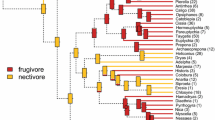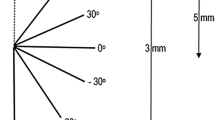Summary
The relationship between sucrose concentration of nectar and volume uptake rate by the butterflies Agraulis vanillae (Nymphalidae) and Phoebis sennae (Pieridae) was examined. Recent theoretical models simulating feeding energetics of nectarivores have assumed that this volume uptake rate is produced by a constant but undetermined pressure drop (the difference between pressure at the proximal and distal ends of the feeding channel) at all nectar concentrations. These models predict that nectar of 20–25% sucrose maximizes the rate of energy intake and should thus be preferred by nectarivores. Data collected for Agraulis and Phoebis falsify this pressure drop assumption; both species produce greater pressure drops with increasing nectar concentration. In addition, males of both species produce greater suction pressure and uptake rates than females. This results in greater rates of energy intake for males of both species. The volume uptake rates produced by each species differ from those predicted by the models. This produces a maximal rate of energy intake at 35–40% sucrose rather than 20–25%. The empirically determined relationship between energy intake rate and nectar concentration esembles that predicted for discontinuous nectar feeders such as hummingbirds more closely than the relationship predicted for continuous suction feeders, suggesting that other basic assumptions about the feeding mechanism of butterflies should be critically examined.
Similar content being viewed by others
References
Baker HG, Baker I (1973) Amino acids in nectar and their evolutionary significance. Nature 241:543–545
Baker HG, Baker I (1975) Nectar constitution and pollinator plant coevolution. In: Gilbert LE, Raven PH (eds) Animal and Plant Coevolution. University of Texas Press, Austin, Texas, pp 100–140
Baker HG, Baker I (1983) Floral nectar sugar constituents in relation to pollinator type. In: Jones CE, Little RJ (eds) Handbook of Experimental Pollination Biology. pp 117–141
Heinrich B (1983) Insect foraging energetics. In: Jones CE, Little RJ (eds) Hanbbook of Experimental Pollination Biology. pp 187–214
Heyneman AJ (1983) Optimal sugar concentrations of floral nectars—dependence on nectar energy flux and pollinator foraging costs. Oecologia (Berlin) 60:198–213
Kingsolver JG (1983) Ecological significance of flight activity in Colias butterflies: implications for reproductive strategy and population structure. Ecology 64:546–551
Kingsolver JG, Daniel TL (1979) On the mechanics and energetics of nectar feeding in butterflies. J Theor Biol 76:167–179
Kingsolver JG, Daniel TL (1983) Mechanical determinants of nectar feeding strategy in hummingbirds: energetics, tongue morphology, and licking behavior. Oecologia (Berlin) 60:214–226
May PG A simple method for measuring nectar extraction rates in butterflies. J Lepidopterists' Society (in press)
Pyke GH, Pulliam HR, Charnov EL (1977) Optimal foraging: a selective review of theory and tests. Quart Rev of Biology 52:137–154
Pyke GH, Waser NM (1981) The production of dilute nectars by hummingbird and honeyeater flowers. Biotropica 13:260–270
Schoener TW (1971) Theory of feeding strategies. Ann Rev Ecol Syst 11:369–404
Stanton ML (1982) Searching in a patchy environment: foodplant selection by Colias p. eriphyle butterflies. Ecology 63:839–853
Watt WB, Hoch PC, Mills SG (1974) Nectar resource use by Colias butterflies: chemical and visual aspects. Oecologia (Berlin) 14:353–374
Weast RC (ed) (1974) Handbook of Chemistry and Physics. 55th edition. CRC Press, Cleveland, Ohio
Author information
Authors and Affiliations
Rights and permissions
About this article
Cite this article
May, P.G. Nectar uptake rates and optimal nectar concentrations of two butterfly species. Oecologia 66, 381–386 (1985). https://doi.org/10.1007/BF00378303
Received:
Issue Date:
DOI: https://doi.org/10.1007/BF00378303




